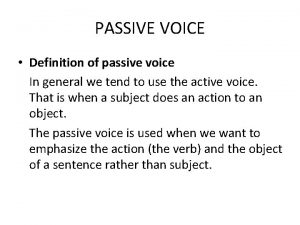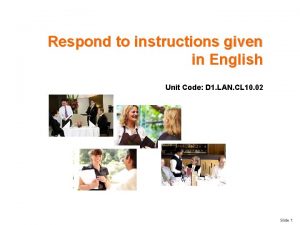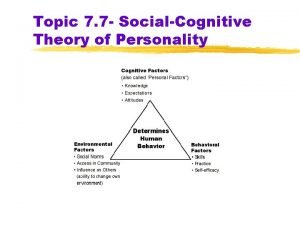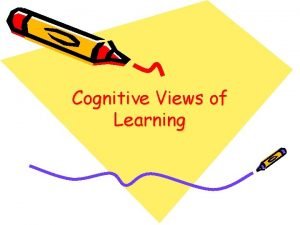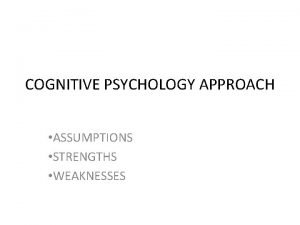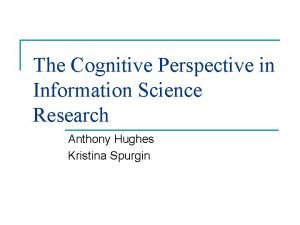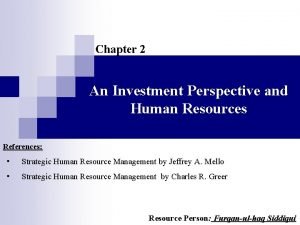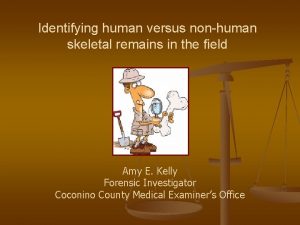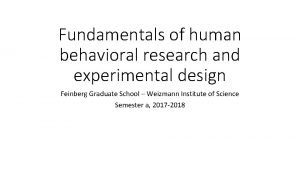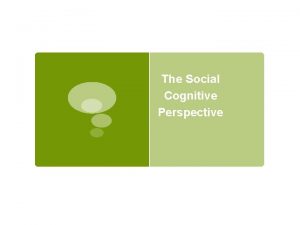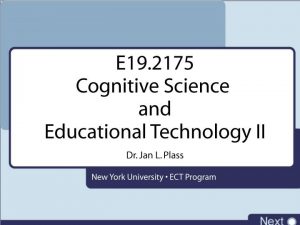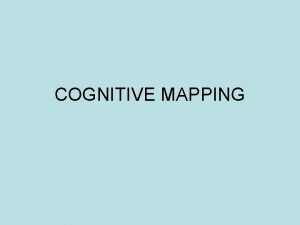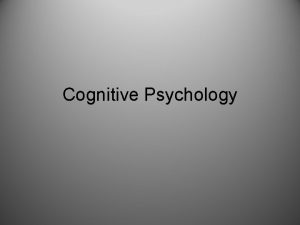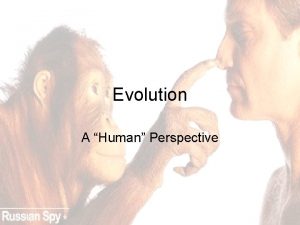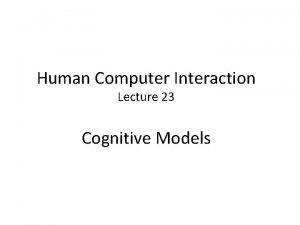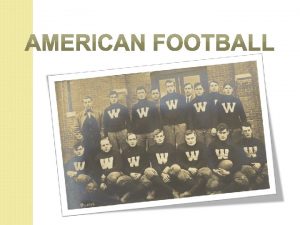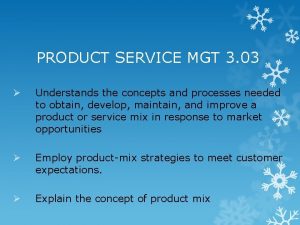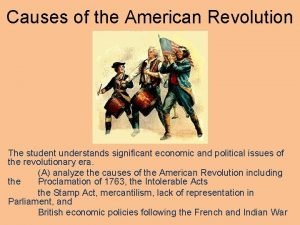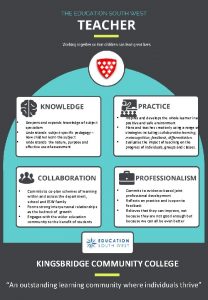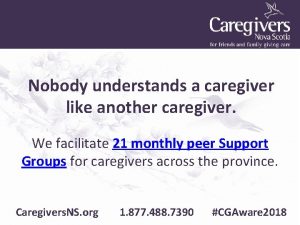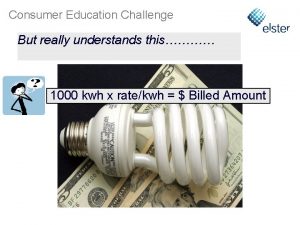Memory Human Memory The cognitive perspective understands memory







































































- Slides: 71

Memory

Human Memory • The cognitive perspective understands memory as – A system that includes all of the information in a person’s mind and, – The mind’s capacity to store and retrieve that information`

Three Stage Memory Processing • Encoding : putting info into our brains • Storage: keeping the info you put into your brains • Retrieval: getting the info from your brain back out to use

• Encoding – The processing of information into our memory system – Many ways in which we encode, or acquire, information • Visual Encoding – Encoding of picture images • Acoustic Encoding – Encoding of sound, especially the sound of words

ENCODING • Automatic Processing – Unconscious encoding of incidental information • Space • Time • Frequency – Effortless processing – All of this processing occurs without needing to pay attention because of the brain’s ability to parallel process

• Effortful Processing – Encoding that requires attention and conscious effort • Experience and practice make these processes automatic – Ex. Reading, walking • Often produces durable and accessible memories – Rehearsal • Conscious repetition of information, either to maintain it in consciousness or to encode it for storage

• Rehearsal cont… – We retain information better when rehearsal is distributed over time – Known as the Spacing Effect • Thus, it is always better to study information over time, instead of just cramming – Serial-Position Effect (Combination of Primacy and Recency Effects) • Our tendency to best recall the first and last items in a list • BUT, after a delay, recall is best of the first items

• Encoding cont… – Semantic encoding • Encoding of meaning, including the meaning of words • Processing by meaning produces better recognition at a later time, than does shallow processing (visual/acoustic) • Imagery (mental images) combined with semantic encoding is a powerful way to remember – Our most vivid images tend to color our memories – Highly durable, but they can be of our best and worst moments

• Semantic encoding cont… – Mnemonics • Memory aids, especially techniques that use vivid imagery and organizational devices – Examples include acronyms » HOMES, ROY G BIV, SWAT, SEAL – My Very Eager Mom Just Served Us Nine Pizzas (9 Planets) – Chunking • Organizing items into familiar, manageable units; often occurs automatically • Happens so naturally that we take it for granted • We remember best when we can organize information into personally meaningful arrangements

Remember this… 9. 2918121776235459045007

How to remember that number 9. 29 = today’s date 1812 = War of 1812 = Repeats 1776 = Declaration of Independence 235 = 2+3=5 459045 = 45 x 2 = 90/2 = 45 (Or think of a triangle) • 007 = James Bond • • •

Fun with Memory • You have 30 seconds to look at the following letters: • CI AFB IKG BDN ABB C UKC NNU SA

Fun with Memory • You have 10 seconds to look at the following group of letters: • CIA FBI KGB DNA BBC UK CNN USA

Dog Cat Horse Cow Apple Orange Pear Banana Chair Table Bed Sofa Knife Gun Rifle Bomb Cotton Wool Silk Rayon Blue Red Green Yellow Knife Spoon Fork Pan Hammer Saw Nails Screwdriver Oil Gas Coal Wood Doctor Lawyer Teacher Dentist Football Baseball Basketball Tennis Shirt Socks Pants Shoes

ANIMALS Dog Cat Horse Cow FRUIT Apple Orange Pear Banana FURNITURE Chair Table Bed Sofa WEAPONS Knife Gun Rifle Bomb CLOTH Cotton Wool Silk Rayon COLORS Blue Red Green Yellow UTENSILS Knife Spoon Fork Pan TOOLS Hammer Saw Nails Screwdriver FUELS Oil Gas Coal Wood PROFESSIONS Doctor Lawyer Teacher Dentist SPORTS Football Baseball Basketball Tennis CLOTHING Shirt Socks Pants Shoes

Types of Memory • Short-Term Memory – Activated memory that holds a few items briefly before the information is stored or forgotten – Involves conscious, active processing of incoming auditory and visual‐spatial information, and of information retrieved from long‐term memory • Has a limit of 5‐ 9 items (and retention time of about 30 secs) – 7 digits of a phone number while dialing – Also known as the “Working” memory

Types of Memory Long-Term Memory – Relatively permanent and limitless storehouse of the memory system • Includes knowledge, skills, and experiences • Implicit Memory (Type of long-term) • Procedural Memory • Our motor and cognitive skills – Walking, talking, reading, writing, driving, riding a bike, etc. – Retention is independent of conscious recollection – Effects of classic and operant conditioning are found in this sub‐type of long‐term memory

• Explicit Memory – Memory of facts and experiences that one can consciously know and “declare” • Declarative memory • Semantic and episodic memories are found within this sub‐type

Storage Definition: • Retaining Information • Keeping information in our brains • Working Memory/Short Term Memory • Long Term Memory

Storage – Sensory Memory • The immediate, very brief recording of sensory information • Iconic Memory – Momentary sensory memory of visual stimuli – Photographic or picture‐image memory last no more than a few tenths of a second » We have amazing visual recall ability but only for a split second – Our visual screen clears quickly

Storage • Sensory memory cont… – Echoic memory • Momentary sensory memory of auditory stimuli • If attention is elsewhere, sounds and words can still be recalled within 3 or 4 seconds – How we are able to remember the last words in a conversation where we were not paying full attention

Stress and Memory • During periods of stress, our bodies react making more glucose available to fuel the brain, the limbic system is activated and proteins are released in the memory‐forming areas of the brain. • Arousal can both sear certain events into our brains and disrupt memory of events happening at the same time.

Memory • Flashbulb Memory – A clear memory of an emotionally significant moment or event • JFK’s assassination, 9/11, etc. are common examples for recent generations of Americans

Retrieval Definition: • Getting the information out

Fun with Memory • • • • Name the Capitals of the following countries: Norway France Tibet Italy Uruguay Australia Spain Poland Denmark Peru Egypt Nicaragua Thailand

Retrieval Cues • • • • What if I gave you hints? Norway O France P Tibet L Italy R Uruguay M Australia C Spain M Poland W Denmark C Peru L Egypt C Nicaragua M Thailand B

Retrieval Cues • • • • What if I gave you hints? Norway Os France Pa Tibet L Italy Ro Uruguay Mo Australia Ca Spain Ma Poland Wa Denmark Co Peru Li Egypt Ca Nicaragua M Thailand Ba

• • • • Answers Norway France Tibet Italy Uruguay Australia Spain Poland Denmark Peru Egypt Nicaragua Thailand Oslo Paris Lhasa Rome Montevideo Canberra Madrid Warsaw Copenhagen Lima Cairo Managua Bangkok

Retrieval • State‐Dependent Memory (a. k. a. Mood Congruent Memory) – What we learn in one state is sometimes more easily recalled when we are again in that state • Joyful, sad, drunk, or sober • Depression and being drunk disrupts encoding and storage, therefore sometimes memories are more easily recalled when in that state again

Examples of State Dependent Memory • Rats taught to run a maze under the influence of a depressant drug will often forget the route through the maze if tested later without the drug. Given the drug again, they retrieve their memory and run the maze successful. • Heavy drinkers may forget what they did while drunk, only to remember again the next time they drink. This phenomenon has been documented under experimental conditions using word lists. • Blount and Cox (1982) tested 80 college students at the University of Minnesota in Morris, looking for evidence of state‐dependent learning effects due to caffeine. Subjects who consumed caffeinated drinks during the learning phase were compared with subjects who did not. Half of each group was given caffeinated drinks before the memory test. There was no effect due to the caffeine. The researchers concluded, "Caffeine's effects on memory are different from the effects of depressants. ”

Retrieval • Context‐Dependent • The tendency to recall experiences that are consistent with one’s current good or bad mood • When we are sad, we tend to think about other sad moments/experiences

• when a student tries to recall information in an exam, they will be able to recall it best if they learned it in an environment which is similar to the exam environment

Forgetting • Seven Sins of Memory • Three Sins of Forgetting: – Absent-Mindedness: Inattention to details produces encoding failure (Mind elsewhere as you put down car keys) – Transience: Storage decay over time (unused information fades) – Blocking: Inaccessibility of stored information (retrieval failure)

Forgetting • Three Sins of Distortion: – Misattribution: Confusing the source of information (putting words in someone else’s mouth) – Suggestibility: lingering effects of misinformation (a leading question later becomes a false memory) – Bias: belief‐colored recollections (current feelings towards someone may color their initial feelings)

Forgetting • One Sin of Intrusion: – Persistence: Unwanted memories (being haunted by images of a violent attack)

Sins of Forgetting • Encoding Failure • We cannot remember what we have not encoded • Information is not encoded from short‐term to long‐term memory, therefore it cannot be remembered

Encoding Failure • http: //www. exploratorium. edu/exhibits/com mon_cents/index. html

Sins of Forgetting • Storage Decay – Even if we encode something well, we can forget it later on • Ebbinghaus’ Forgetting Curve – Much of what is learned is quickly forgot – BUT, levels off over time – Ebbinghaus and Bahrick’s experiments – Still learning about why the physical storage of memory decays

Ebbinghaus’ Curve

U. S. Capitals • • • • South Dakota Montana Iowa Florida Mississippi Texas Vermont Maine Rhode Island Nevada Colorado California New York Illinois

Capitals • • • • South Dakota Montana Iowa Florida Mississippi Texas Vermont Maine Rhode Island Nevada Colorado California New York Illinois P H I T J M A P C D S A

Capitals • • • • South Dakota Montana Iowa Florida Mississippi Texas Vermont Maine Rhode Island Nevada Colorado California New York Illinois Pi He Io Ta Ja Mo Au Pr Ca De Sa Al Sp Au

Capitals • • • • South Dakota Montana Iowa Florida Mississippi Texas Vermont Maine Rhode Island Nevada Colorado California New York Illinois Pierre Helena Iowa City Tallahassee Jackson Austin Montpelier Augusta Providence Carson City Denver Sacramento Albany Springfield

Sins of Forgetting • Retrieval Failure • Sometimes information gets into our brain that we just cannot get out • “Tip‐of‐the‐Tongue” phenomenon • Information is there wanting to be retrieved • Takes a retrieval cue for the person to be able to retrieve the information

Tip‐of‐the‐Tongue • Tip‐of‐the‐tongue (TOT) – Sometimes we know something – We cannot quite access the information • Often it is a word that will not come to mind • Characteristics of Tip of the tongue states – Can often guess the first letter – Can often tell the shape of the word (such as the number of syllables – TOT states can be frustrating

Sins of Forgetting • Interference – Proactive Interference: the disruptive effect of prior learning on the recall of new information – Retroactive Interference: the disruptive effect of new learning on the recall of old information • You can minimize the effects of Retroactive Interference by reducing the number of interfering events – Go for a walk or go to sleep (an hour) after learning new information increases retention

The Interferences


Forgetting • Positive Transfer: When old information is able to facilitate learning of new information – Interference occurs when old and new information compete with each other

Amnesia • Source Amnesia: Attributing to the wrong source an event that we have experienced, heard about, read about, or imagined. – At the heart of many false memories

Amnesia • Anterograde Amnesia: Form of amnesia where new events are not transferred to long‐term memory. – Those who suffer from theoretically pure anterograde amnesia will still be able to remember memories laid down before the onset of anterograde amnesia • But will exist in a transient world where anything beyond their immediate attention‐span disappears permanently from their consciousness. – Different types of memories (e. g. , of new physical skills, of new words, of the events of the day, facts of history, etc. ) can be separately affected by anterograde amnesia.

Amnesia • Anterograde amnesia cont… – Patients with anterograde memory loss often can learn and remember a new physical skill and yet not remember when he or she had learned it. – Examples have been described where patients learned and remembered new words and facts of history ("semantic" memory) but could not remember any events of their previous day ("episodic" memory).

Amnesia • Large intake of alcohol can cause anterograde amnesia – Commonly referred to as blackouts. • Damage to the hippocampus – Famous Cases: • • Clive Wearing 50 First Dates Memento Dory, the blue fish, from Finding Nemo

Amnesia • Retrograde Amnesia: A form of amnesia where someone will be unable to recall events that occurred before the onset of amnesia. – Retrograde amnesia is caused by trauma that results in brain injury. – Retrograde amnesia is often temporally graded, meaning that remote memories are more easily accessible than events occurring just prior to the trauma.

Amnesia • The memory loss may just affect specific “classes” of memory. – For instance the victim, a concert pianist before, may still remember what a piano is after the onset of retrograde amnesia, but may forget how to play. – The relearning rate for often used skills such as typing and math is typically faster than if they had never learned it before. – The victim of retrograde amnesia may feel embarrassed or stressed that they no longer remember key people and significant events

Forgetting Sins of Distortion • Misattribution: Source Amnesia • Suggestibility: Incorporating misleading information into one’s memory of an event. • Misinformation Effect – As a memory fades with time following an event, the injection of misinformation becomes easier – Brings doubt into eyewitness accounts – Even repeatedly imagining nonexistent actions and events can create false memories

Reconstructive Memory

Reconstructive Memory • Reconstructive Memory: – Recall that is hypothesized to work by storing abstract features which are then used to construct the memory during recall • Loftus experiment – We “fill‐in‐the‐gaps” when recalling previous memories – Often leads to false memories that we are very confident in

Flashbulb Memory • Underline the facts – just the facts • Highlight the emotions • Circle the auditory stimuli • Box the visual stimuli

Loftus Experiment 1974 • The aim of this study was to investigate how information supplied after an event, influences a witness's memory for that event. • demonstrated through the use of leading questions how it is possible to distort a person’s memory of an event

1 st Experiment • 45 students of Univ. of Washington • Shown seven film‐clips of traffic accidents (driver ed films 5‐ 30 seconds long) • Asked to write an account of accident and answer specific questions • Independent variable was manipulated by means of wording of the questions

1 st experiment • For example: • Condition 1: 'About how fast were the cars going when they smashed into each other? ' • Condition 2: 'About how fast were the cars going when they collided into each other? ' • Condition 3: 'About how fast were the cars going when they bumped into each other? ' • Condition 4: 'About how fast were the cars going when they hit each other? • Condition 5: 'About how fast were the cars going when they contacted each other? '

1 st experiment results • • • Loftus and Palmer give two interpretations/explanations of the findings of their 1 st experiment. 1. Firstly, they argue that the results could be due to a distortion in the memory of the participant. The memory of how fast the cars were travelling could have been distorted by the verbal label which had been used to characterize the intensity of the crash. 2. Secondly, they argue that the results could be due to response‐bias factors, in which case the participant is not sure of the exact speed and therefore adjusts his or her estimate to fit in with the expectations of the questioner. (This is also an example of a demand characteristic) Verb Mean Estimate of Speed Smashed 40. 8 Collided 39. 3 Bumped 38. 1 Hit 34. 0 Contacted 31. 8

2 nd experiment • • • 150 student participants viewed a short (one minute) film which contained a 4 second scene of a multiple car accident, and were then questioned about it. There were three conditions and the independent variable was manipulated by the wording of the question. 50 of the participants were asked 'How fast were the cars going when they hit each other? ’ 50 of the participants were asked 'How fast were the cars going when they smashed into each other? ' 50 of the participants were not interrogated about the speed of the vehicles. One week later, the participants returned and, without viewing the film again, they answered a series of questions about the accident. The critical question was 'Did you see any broken glass? ' The critical question was part of a longer series of questions and was placed in a random position on each participants question paper. There was in fact no broken glass in the film.

2 nd experiment Results Response Smashed Hit Control Yes 16 7 6 No 34 43 44 Loftus argued that two kinds of information go into a person's memory of an event. The first is the information obtained from perceiving an event (e. g. witnessing a video of a car accident), and the second is the other information supplied to us after the event (e. g. the question containing hit or smashed). Over time, the information from these two sources may be integrated in such a way that we are unable to tell from which source some specific detail is recalled. All we have is one 'memory'. This explanation is often referred to as the reconstructive hypothesis.

Reconstructive Memory • Tom was flying from San Diego to the Bahamas on Flight #639. After the flight took off, three men from the People’s Liberation for Oppressed Peoples hijacked the flight and wanted to divert the plane to Panama. The Pilot Jane and Co‐Pilot Jack locked the cockpit door and attempted to land the plane in Texas. The hijackers tried to break down the cockpit door, but were unsuccessful. Jane took the gun from the cockpit and shot two of the hijackers. Passengers subdued the other hijacker, as Jane was able to land in New Orleans.

Reconstructive Memory • Leveling‐ simplifying the story • Sharpening‐ overemphasizing or highlighting certain details • Assimilating‐ changing details to fit own background or knowledge

Eye‐Witness Testimony • http: //www. psychology. iastate. edu/faculty/g wells/homepage. htm

Forgetting

Facial Recognition • How do we remember a face? – The upper part of the face seems to be more important for recognition than the lower part. – The hair turns out to be the most important factor, followed by the eyes, then the nose, and then to a lesser extent, the mouth and chin. • So if you're going to rob a bank, wear a wig, and don't bother with the fake beard.

Fun with Memory • http: //www. youramazingbrain. org/testyourse lf/eyewitness. htm • http: //www. lumosity. com/brain‐ games/problem‐solving‐games/word‐sort
 The boy writes poems passive voice
The boy writes poems passive voice God understands your pain
God understands your pain Responding to instructions
Responding to instructions Cognitive and non cognitive religious language
Cognitive and non cognitive religious language Social cognitive perspective of personality
Social cognitive perspective of personality Cognitive perspective
Cognitive perspective Strengths and weaknesses of cognitive approach
Strengths and weaknesses of cognitive approach Cognitive perspective definition
Cognitive perspective definition Andrea yates cognitive perspective
Andrea yates cognitive perspective One point perspective boxes
One point perspective boxes Silo perspective vs business process perspective
Silo perspective vs business process perspective Investment perspective of human resource management
Investment perspective of human resource management Investment perspective of hr
Investment perspective of hr Hình ảnh bộ gõ cơ thể búng tay
Hình ảnh bộ gõ cơ thể búng tay Frameset trong html5
Frameset trong html5 Bổ thể
Bổ thể Tỉ lệ cơ thể trẻ em
Tỉ lệ cơ thể trẻ em Chó sói
Chó sói Thang điểm glasgow
Thang điểm glasgow Chúa yêu trần thế alleluia
Chúa yêu trần thế alleluia Các môn thể thao bắt đầu bằng tiếng đua
Các môn thể thao bắt đầu bằng tiếng đua Thế nào là hệ số cao nhất
Thế nào là hệ số cao nhất Các châu lục và đại dương trên thế giới
Các châu lục và đại dương trên thế giới Cong thức tính động năng
Cong thức tính động năng Trời xanh đây là của chúng ta thể thơ
Trời xanh đây là của chúng ta thể thơ Mật thư tọa độ 5x5
Mật thư tọa độ 5x5 Phép trừ bù
Phép trừ bù độ dài liên kết
độ dài liên kết Các châu lục và đại dương trên thế giới
Các châu lục và đại dương trên thế giới Thơ thất ngôn tứ tuyệt đường luật
Thơ thất ngôn tứ tuyệt đường luật Quá trình desamine hóa có thể tạo ra
Quá trình desamine hóa có thể tạo ra Một số thể thơ truyền thống
Một số thể thơ truyền thống Cái miệng bé xinh thế chỉ nói điều hay thôi
Cái miệng bé xinh thế chỉ nói điều hay thôi Vẽ hình chiếu vuông góc của vật thể sau
Vẽ hình chiếu vuông góc của vật thể sau Thế nào là sự mỏi cơ
Thế nào là sự mỏi cơ đặc điểm cơ thể của người tối cổ
đặc điểm cơ thể của người tối cổ Thế nào là giọng cùng tên?
Thế nào là giọng cùng tên? Vẽ hình chiếu đứng bằng cạnh của vật thể
Vẽ hình chiếu đứng bằng cạnh của vật thể Vẽ hình chiếu vuông góc của vật thể sau
Vẽ hình chiếu vuông góc của vật thể sau Thẻ vin
Thẻ vin đại từ thay thế
đại từ thay thế điện thế nghỉ
điện thế nghỉ Tư thế ngồi viết
Tư thế ngồi viết Diễn thế sinh thái là
Diễn thế sinh thái là Dot
Dot Số nguyên tố là
Số nguyên tố là Tư thế ngồi viết
Tư thế ngồi viết Lời thề hippocrates
Lời thề hippocrates Thiếu nhi thế giới liên hoan
Thiếu nhi thế giới liên hoan ưu thế lai là gì
ưu thế lai là gì Khi nào hổ mẹ dạy hổ con săn mồi
Khi nào hổ mẹ dạy hổ con săn mồi Khi nào hổ mẹ dạy hổ con săn mồi
Khi nào hổ mẹ dạy hổ con săn mồi Hệ hô hấp
Hệ hô hấp Từ ngữ thể hiện lòng nhân hậu
Từ ngữ thể hiện lòng nhân hậu Thế nào là mạng điện lắp đặt kiểu nổi
Thế nào là mạng điện lắp đặt kiểu nổi Human vs non human bones
Human vs non human bones 8.3 human needs
8.3 human needs Chapter 8 human needs and human development
Chapter 8 human needs and human development Gni definition ap human geography
Gni definition ap human geography Non human nouns
Non human nouns Human memory management
Human memory management Types of human memory
Types of human memory Semantic memory example
Semantic memory example Implicit and explicit memory
Implicit and explicit memory Long term memory vs short term memory
Long term memory vs short term memory Internal memory and external memory
Internal memory and external memory Primary memory and secondary memory
Primary memory and secondary memory Logical address
Logical address Which memory is the actual working memory?
Which memory is the actual working memory? Virtual memory
Virtual memory Virtual memory in memory hierarchy consists of
Virtual memory in memory hierarchy consists of Eidetic memory vs iconic memory
Eidetic memory vs iconic memory
